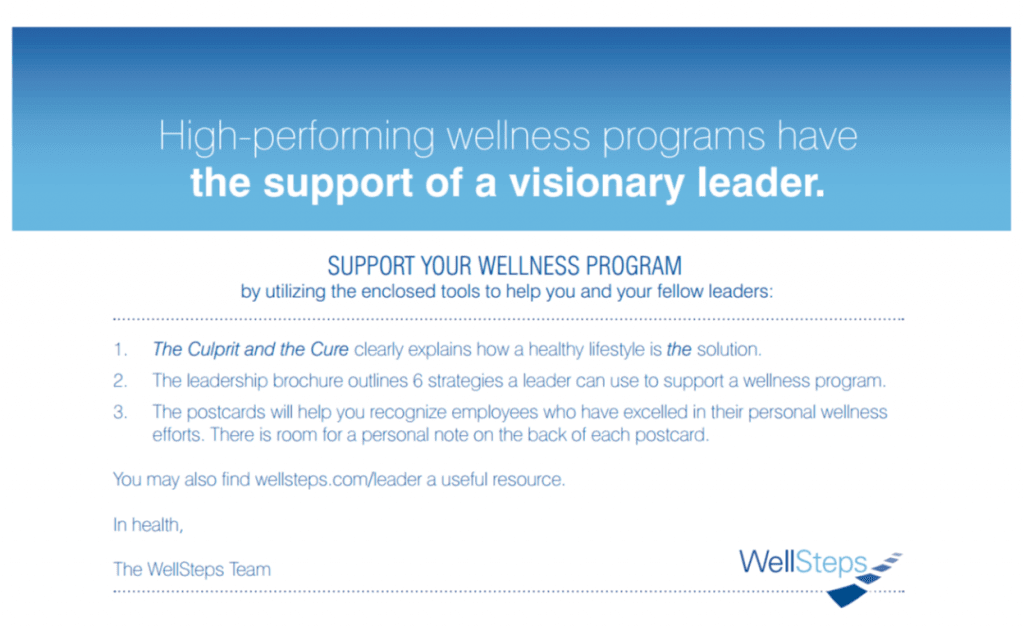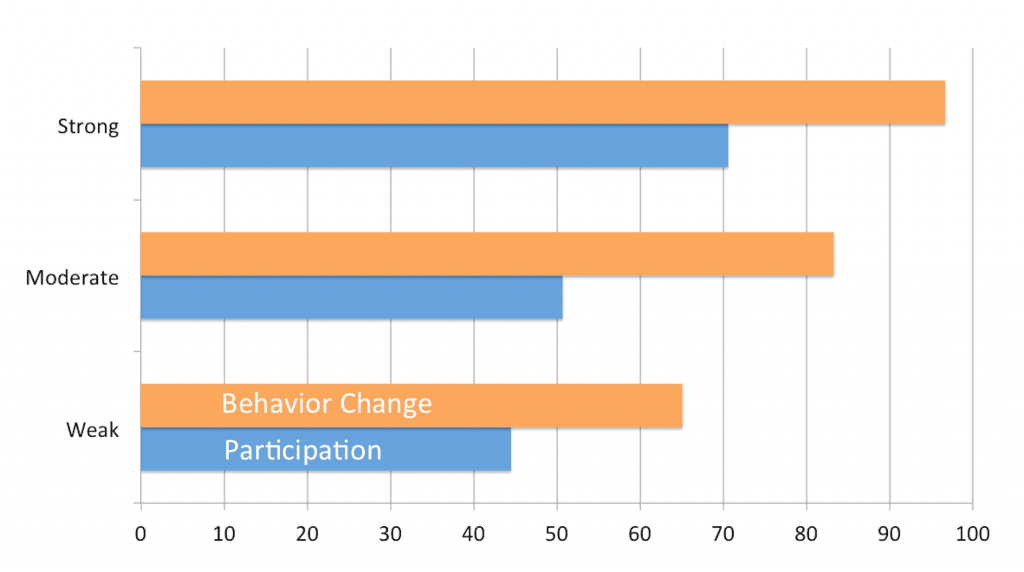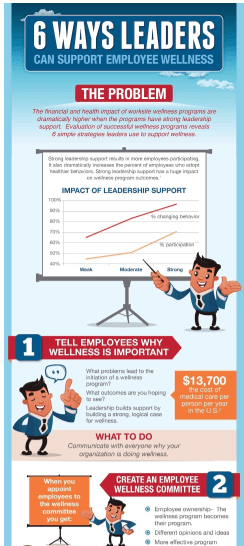The wellness programs that have the best return on investment tend to exist in organizations with strong leadership support for employee wellness. What senior leaders do at our places of work is an important factor in our behavior. Here are some case studies and research findings that demonstrate this:
Case Study Number One:
A few years back, WellSteps worked with Kaiser Permanente to deliver the WellSteps Small Business Solution to dozens of companies.
After this program was over, the companies were placed into one of the three groups based on their leadership support for employee wellness: Weak, Moderate, or Strong. We then looked at the percentage of employees who participated and who changed at least one behavior.
As shown above, companies with stronger leadership support (bars on top) had far greater participation and had more employees who reported changing at least one behavior. This data also shows what is known as a graded response.
Though not ideal, moderate leadership was better than weak leadership, suggesting that at least some leadership support for employee wellness is better than none. Strong leadership support is even better.
In fact, strong leadership support was worth an additional 25 percentage points in participation and over 30 percentage points in behavior change. The stronger the leadership support, the more the employees participated and changed their behavior.
Case Study Number Two:
In 2012, the data from 455 companies who voluntarily completed the scorecard from the Health Enhancement Research Organization were evaluated. The full report of this analysis is provided here.
In this evaluation, the relationship between supportive wellness leadership and both employee health risks and employee cost was examined. Each company was placed into one of three groups according to their degree of leadership support for employee wellness, from “marginal” to “supportive” to “very supportive.”
In like manner, improvement in employee health risk or cost was grouped from “none” to “substantial.” We expected that more companies with very supportive wellness leadership would also report much larger improvements in health risk and/or cost.
We also expected the opposite to be true. In other words, among companies with marginally supportive leadership, we anticipated those companies would have poorer results. Here is what we found: the companies with very supportive leadership were 4.2 times more likely to report substantial improvement in employee health risk.
They were also 2.5 times more likely to report substantial reduction in medical costs. The companies with marginally supportive leadership, were about 4 times more likely to report no improvement in employee health risk or reduction in medical costs.
Case Study Number Three:
In this analysis, we compared wellness leadership levels within two WellSteps customers. One company had very strong leadership and environmental/policy support and the other did not.
The company with strong leadership support took advantage of all the WellSteps marketing and communication tools, had an engaged, participating senior leader and had an engaged wellness committee. The company with poor leadership support placed the full responsibility for the wellness program success on a member of the HR team.
None of the leaders in this group participated in any of the wellness initiatives, the wellness committee was non-existent, and there was little recognition given to any employees who were participating.
Not surprisingly, the supportive company had participation that was 2.2 times greater and a successful program completion rate that was 4.2 times greater.

All the employees in this company knew that the company wellness program was important because they saw the senior leaders both participating and encouraging others to participate. The most successful wellness programs are those that have leaders that model program participation that they want to see from employees.
Case Study Number Four:
In 2016, the Institute for Health and Productivity Studies published a comprehensive study to identify key success elements of employer-sponsored health promotion (wellness) programs.
They used three methods to identify the success elements: a review of the relevant peer-reviewed literature focused on best practices, discussions with experts in the field, and site visits to companies with proven programs.
The key determinant of success was the ability to create a culture of health at the workplace and this is only possible with the support of visionary wellness leadership. The authors summed up the importance of leadership support this way:
In these successful programs, leaders consistently express the importance of employee health and well-being to the organization (through words, actions, and policies) and devote sufficient resources to health promotion efforts, even if programs are not expected to save money immediately.
These case studies and published reports document with evidence and data what most of us already know: Wellness programs that have strong leadership support produce positive wellness outcomes.
How To Cultivate Leadership Support for Workplace Wellness
Case studies and published reports provide evidence that leadership modeling shapes employee behavior. There is no question that wellness programs with strong leadership support produce positive wellness outcomes.
The hard part is helping leaders see that a healthy workforce is good for business, leading them to provide meaningful support. So, what can brokers, wellness professionals, and managers do to help leaders cultivate support for workplace wellness?
Over the years, WellSteps has struggled with this question as well. In 2015, WellSteps studied the qualities of the leaders that had the best wellness programs in our book of business. Specifically, we were interested in those companies with the best 2, 3, 4, and 5 year outcomes.
We boiled these strategies down to the very best and included them in this info-graphic.
What Can Senior Leaders and Managers do to Promote Employee Wellness?
Below is a more complete list of the best strategies. If you want to see an even bigger list of strategies, go here.
All of these strategies are intended to help leadership make small, meaningful steps toward supporting company wellness efforts. We share this information because we think that brokers and wellness professionals can help leaders apply these strategies. And when they do, the engagement in and impact of a company wellness program will dramatically improve.
Encourage:
- Managers and employees to participate in wellness activities
- The company to meet specific wellness goals
- Departments or locations to compete as appropriate during behavior change campaigns
- Employees to get enough rest to promote holistic wellness
- Members of the company to give back to the community
Recognize:
- Employees for exemplary achievements in the wellness program
- Departments or sites for high participation
- Department managers who meet wellness goals
Participate:
- In wellness activities, including the kickoff meeting
- In lunchtime “CEO walks” or in community walks/ fun-runs, and share pictures!
- In recreational activities with employees
Support Policy to:
- Allow flexible break times so employees can be active
- Create healthy vending and catering options
- Become a smoke-free campus
- Promote disaster preparedness
Influence the Workplace Culture of Health by:
- Emphasizing wellness in the mission statement
- Arranging for fresh fruits and vegetables to be delivered on a regular basis
- Moving your parking space to the far side of the parking lot
- Keep employees connected and show that everyone is supporting one another
Another Example of Leadership Support for Wellness
Using many of these same strategies, the leadership at Townsend Industries was able to create a culture of health. This assisted in building an organization that employees love.
Here is the story Townsend Industries. In short, they used leadership support to create a best in class wellness program. All while they kept employee turnover to less than 1% over a 10-year period.
How To Reach Out To Leaders
In truth, some wellness coordinators and committee members are not comfortable making suggestions to company leadership about how they can be a better leader, which is completely understandable. That’s why WellSteps also created a leadership support kit.
Pictured below, is this gift box. In summary, it contains:
- a printed copy of the leadership infographic
- a cover letter suggesting how these ideas can be part of an effective business strategy
- simple post cards that can be used to recognize employees who have excelled in their personal wellness efforts
- and, a copy of the best-selling book about wellness, The Culprit and The Cure.
No leader is going to be angry or offended with these sincere and professional materials. So, if nothing else, this kit will help start a conversation about what can be done to support the wellness program.


Overcoming Leadership Concerns When you Start an Employee Wellness Program
One of the common concerns of leadership is the return on investment (ROI) of an employee wellness program and where to find the money to fund a wellness program. In order to estimate ROI, we suggest you use the WellSteps ROI Calculator here.
It is based on every piece of published scientific evidence on the effectiveness of workplace wellness programs, and is updated every other year to reflect the most recent findings. To see all the references, just click on the “Science” tab on the lower left corner.
So What?
Leadership support for workplace wellness is a critical driver of program success, especially when you first start a wellness program. Published research and multiple case studies show how program outcomes are dramatically better when they have support from leaders.
Use these strategies to help company leaders become more involved and engaged so that the wellness program will meet the goals of all stakeholders.
What Should Be Included in an Employee Wellness Program?
If you are an already supportive senior leader who is interested in implementing or improving a wellness program, but you’re not sure where to begin, let the experts at WellSteps help you! You can work with a WellSteps Guide to create a wellness program tailored to your company’s specific needs. Combine an excellent wellness platform with your enthusiasm for wellness to create a successful, meaningful program at your company!



We have found that actively supportive leadership from the get-go would be ideal but in those client groups who have not “started” in that way, it’s where we’re encouraging them to take next steps. We too, are seeing undeniably better outcomes in participation and health risks as identified by our health risk questionnaires, culture assessments and health screening biometrics. Leadership support and involvement is key.
Comments are closed.